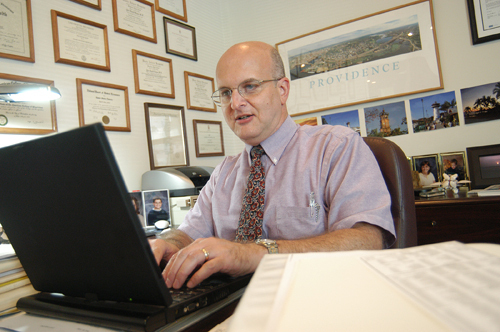
In the world of e-prescribing, Dr. Yul D. Ejnes is a pioneer. In 2003, he was among the first in Rhode Island to transmit a prescription electronically, as part of a pilot project with the national network SureScripts. Today, he writes more than 90 percent of prescriptions online.
He strongly believes in the power of e-prescribing to improve quality and safety while cutting costs. He has seen the technology’s impact on his own practice, Coastal Medical Inc.
And yet even in Rhode Island, the state with the highest percentage of office-based doctors e-prescribing last year, according to SureScripts, Ejnes is in the minority: Only 29 percent of local doctors e-prescribed in 2007, and only for 9.05 percent of eligible prescriptions and refills.
Nationally, SureScripts estimated in a recent report, only about 6 percent of U.S. office-based doctors e-prescribed last year, and only about 2 percent of 1.47 billion eligible prescriptions were sent electronically.
Things are changing fast, however: More doctors e-prescribed in the first 10 months of 2007, SureScripts says, than in 2004, 2005 and 2006 combined. This year, SureScripts expects 7 percent of all eligible prescriptions to be sent online, and it expects the number of doctors involved to more than double, from 35,000 to 85,000.
Last month, the Centers for Medicare and Medicaid Services (CMS) offered a new reason to go electronic: Starting in 2009, Medicare will provide incentive payments to e-prescribers: 2 percent in 2009 and 2010, 1 percent in 2011 and 2012, and half a percent in 2013.
Starting in 2012, meanwhile, doctors who don’t e-prescribe will actually have their pay cut, CMS said, unless they can show complying would involve a “significant hardship.”
Consumers are also being urged to ask their doctors to e-prescribe, through signs and educational materials at CVS/pharmacy and other locations.
But why does e-prescribing matter, and if it really makes a big difference, why are hundreds of thousands of doctors still scribbling prescriptions on paper pads?
For starters, there’s the handwriting – when pharmacists have to struggle to read the drug name or dosage, it’s easy to make a mistake. Plus a doctor using a pad may not have all the information he needs about other drugs a patient is taking, or known allergies.
Altogether, those factors make it necessary for pharmacists to make follow-up calls on about 30 percent of prescriptions, according to SureScripts. Even worse, errors still occur.
According to the Center for Information Technology Leadership, e-prescribing with advanced decision support could help prevent 130,000 life-threatening medication errors a year. CMS, in announcing its e-prescribing incentives, estimated that Medicare would save up to $156 million over five years in avoided adverse drug events.
E-prescribing also saves time, supporters say: from avoided follow-ups, time spent calling in prescriptions and refills, time at the fax machine. When Coastal Medical first joined the SureScripts pilot, Ejnes said, it started with just refills, and yet “within hours … the amount of time that the staff were using to do prescriptions dropped dramatically,” he said.
Plus, for insurers and consumers, e-prescribing can save money by making it easier for doctors to prescribe lower-cost and generic drugs. Blue Cross Blue Shield of Massachusetts, for example, has said e-prescribers saved 5 percent on drug costs vs. their peers in 2006, including $800,000 saved by patients from lower copayments.
Shannon Nelson, director of primary care operations for UnitedHealthcare, which is running a national pilot program to encourage e-prescribing, said when doctors can look up the cost of a drug online before prescribing it, and talk with the patient to ensure it’s affordable, it appears to increase the chances that the patient will take the medication – a big deal given that about 20 percent of prescriptions now go unfilled.
And yet paper still rules. How come?
Laura Adams, president and CEO of the Rhode Island Quality Institute, which has run the pilot program with SureScripts, said advocates have found many substantial barriers.
First and foremost, technology costs money: You need computers, Internet connections, software and/or a service subscription to e-prescribe.
There’s also a work flow issue, Adams said. Most doctors don’t have computers in the exam rooms, so while they can write on a pad while talking with the patient, they might have to go to a separate work station to e-prescribe. Ejnes himself said this is why at first, he only did refills online – until Coastal got electronic medical records and computerized the exam rooms. Studies have found this is a big obstacle in doctors’ minds, even though it’s manageable.
The U.S. Drug Enforcement Administration has also gotten in the way. Controlled substances cannot be prescribed online, so if a patient needs, say, phenobarbital, it has to be prescribed on paper or called in. These drugs account for about 13 percent of all prescriptions.
Rhode Island is a leader in e-prescribing, second only to Massachusetts in the total number of prescriptions sent electronically in 2007, and yet even here, with Coastal – the state’s largest independent physician group practice – and the Lifespan system leading the way, progress has been disappointingly slow, Adams acknowledged.
When Gov. Donald L. Carcieri recently held a meeting with doctors and vendors offering free e-prescribing tools, Adams noted, there were very few takers. “Free wasn’t cheap enough to get the conversion,” she said.
To encourage e-prescribing, Blue Cross & Blue Shield of Rhode Island is providing incentives as part of its effort to promote EMR adoption and through its Quality Counts program, which rewards doctors for meeting specific targets – a 60-percent rate for e-prescribing. (United’s Premium Designation Program also rewards e-prescribing.)
Ultimately, however, advocates believe the federal government will lead the way. Medicare can make a big difference, they say, by providing a lot more money to help doctors with the conversion and by setting standards.
“Physicians very often can influence each other’s behavior,” Adams said, “when those who are seen as leaders in terms of clinical quality are seen adopting a new procedure.” •











